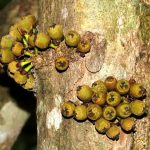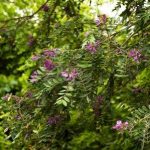TREE LIFE
January 2003
WHILE THE CURRENT FUEL CRISIS PERSISTS IT IS IMPORTANT TO CONFIRM WITH ANY OF THE COMMITTEE MEMBERS THAT THE SCHEDULED OUTINGS AND WALKS CAN ACTUALLY TAKE PLACE.
MASHONALAND CALENDAR
Saturday 4th January: Mark’s Walk will be at Dombashawa. Take the Borrowdale road out of Harare and continue for 33 kms and turn right to Dombashawa Caves. We will meet in the Car park at 2.30 p.m.
N.B The Entrance fee may be in the region of $100.
Tuesday 7th January: Botanic Garden Walk with Tom Müller. Meet in the car park at 4.45 for 5pm The subject will be leguminosae.
Sunday 19th January: On a recent walk with Mark we were very pleasantly surprised to see how well preserved and maintained the area around Harava Dam (Henry Hallam) still is. We decided that this would be a pleasant and interesting venue for our January outing, and as this is the most exciting season botanically, we expect to see much of the herbaceous stuff in flower.
Saturday 25h January: Mark’s Walk will be at St. George’s College, where there is always much of interest. Meet at 2.30 pm in the car park.
Tuesday 4th February: Botanic Garden Walk.
MATABELELAND CALENDAR
Nothing has been arranged for January.
Contact Jonathan Timberlake if you would like to organize a future outing.
His telephone numbers are 09-286529 or 285761(tel/fax) or email timberj@mweb.co.zw
EASTERN HIGHLANDS TEA ESTATE TRIP SUNDAY 29TH SEPTEMBER 2002
Nick Fawcett led our small convoy of 2 vehicles to the north-western corner of the Tea estate. Here there was a magnificent view (through the usual haze) over largely pristine undulating forest, although there were unmistakable signs of individuals cutting out patches in the forest.
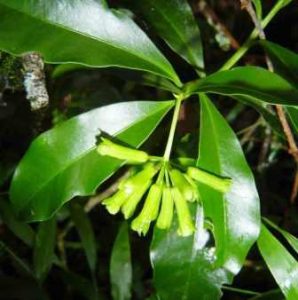
Peddiea africana. Photo: Bart Wursten. Source: Flora of Zimbabwe
Firstly, we went down a gentle slope, taking in two common E Districts species. One was Gouania longispicata, which is a tall climber in the Rhamnaceae. It has alternate leaves which are often brown-hairy and quite striking tendrils; it smothers the vegetation, even tall trees. Another species seen, this time a small forest understorey shrub, was Peddiea africana (Green flower tree) with its eponymous green flowers and its reliable characteristic whereby its branches do not break off cleanly but peel off leaving a long string attached. This is from the family Thymelaeaceae, which includes the genus Daphne, which is rather what this species resembles.
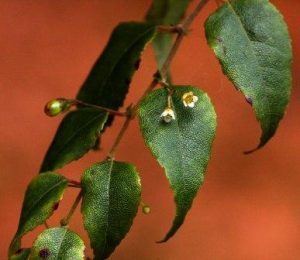
Gerrardina eylesiana. Photo: Bart Wursten. Source: Flora of Zimbabwe
Another slightly unusual species seen was Gerrardina eylesiana (Flacourtiaceae), a shrub with serrate, alternate leaves on long whippy stems. In Zimbabwe it is a shrub of the Eastern Highlands only; the first time I had seen it was on the Nyanga trip in February.
We were heading for a patch of forest which Tom had visited c.25 years before in 1977. As we descended to a stream, it became clear to Tom that the habitat had changed dramatically in that period. Then, it had been open fire-maintained montane grassland, now it had been colonised by young trees.
Tom showed us the succession: Harungana madagascariensis was making the canopy; occasional true forest species (Newtonia buchananii and Aidia micrantha) were coming in in small quantities while the forest edge species (Cussonia spicata and Oxyanthus goetzei) were still present but would eventually be squeezed out. Underneath the quite thick trees and shrubs were the remains of the grassland species, such as Smilax and the grassland aloes, which would also eventually disappear.
Tom also reckoned that this change had only taken place in the last 10 years or so and it was surprising to me how thick it had all become in that time.
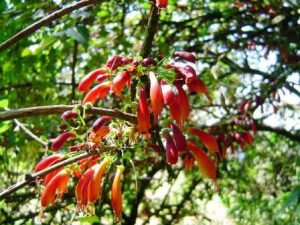
Halleria lucida. Photo: Bart Wursten. Source: Flora of Zimbabwe
At the stream, we came across the climbing forest Strychnos, S. lucens, adapted for its environment by possessing tendrils. Halleria lucida was also in the riverine vegetation and more Psydrax kraussioides, seen on earlier days.
A small shrub with opposite quilted leaves defeated us for a while, until we came across a better specimen later. This was Clerodendrum swynnertonii (now reduced to specific rank as Clerodendrum cephalanthus subsp. swynnertonii). The leaves are fetid as most of our wild clerodendrums are and although we didn’t see flowers, we did see green fruits with a large persistent calyx.
Across the stream, we ascended slowly though the “new” woodland. Mary Clarke showed me the remarkable fern Belvisia spicata with its apical “spike” and later what appeared to be a strange glaucous bracken, Hypolepis sparsisora. A steady flow of new trees was seen: Podocarpus latifolius, Maytenus acuminata (with the remarkable threads when a leaf is pulled apart); Syzygium guineense subsp. afromontanum (probably not S. owariense); Antidesma vogelianum; the ubiquitous Sapium ellipticum; Ochna holstii and Toddalia asiatica.
After a while we stopped for tea, while Tom and Nick reconnoitered ahead. Here we saw two species of Cassipourea: Cassipourea gummiflua and Cassipourea malosana (formerly called C. congoensis).
After a further short walk we entered another forest on a steeper slope with some very large trees in it indeed; this was now no longer re-growth, this was a most impressive patch of forest and the tree species changed accordingly. Tom remarked that the altitude of the forest (c.1150m) was similar to Chirinda and there were some similarities between the two.
Here were very large trees of Chrysophyllum gorungosanum with enormous multiple buttresses and a pale brown slash with a white exudate. Also present were large Anthocleista grandiflora, the latter somewhat unusually as a canopy tree – normally it is more of a pioneer species. Not only did the Chrysophyllum have buttresses, but so too did Myrianthus holstii, probably environmentally induced through growing in a wet place.
Equally enormous (c.50-60 m) was Croton sylvaticus, with its strong-smelling slash. Tom explained how this may be both a pioneer and a climax tree. Also present were the soccer-ball tree, Tabernaemontana stapfiana, Cola greenwayi with its prominent pulvinus and Rawsonia lucida (base symmetrical but otherwise very similar to Drypetes natalensis).
A completely new species to me was Strombosia scheffleri. This is a rare species in the family Olacaceae; we all know the other taxa of Ximenia and Olax which we get in Zimbabwe, but this one is not so frequently seen. As usual, it had the typical forest adaptation of glossy leaves and a long drip-tip -and perhaps more specifically, sunken veins.
Also of interest were Garcinia kingaensis (with the usual yellow latex) and the climbing forest Annonaceae, Uvaria lucida subsp. virens.
And everywhere, throughout the whole trip, there was Agelaea pentagyna. Strictly a climber, it has 3-foliolate leaves (occasionally reduced to 1 : its former name was heterophylla), stellate brown hairs, striking coiled tendrils and the leaves with prominent pulvinuses, which makes it look rather like a legume. However, it actually belongs to the family Connaraceae; it is true that this is generally placed next to the legumes in the flowering order, but how connected they are I don’t know. The plant also has seeds with red arils, but we didn’t see any flowers or fruit on this trip.
After lunch in the forest we walked back to the cars and on the drive back stopped to see Drypetes natalensis in the gathering darkness.
When we got back to the guest house at about 6 p.m. a very warm wind was blowing strongly, clouds were appearing (rather ill-defined in the haze) and shortly after, lightning and thunder began. Soo Fawcett had been hoping that rain would come and clear away the dust and smoke particles in the atmosphere. Although rain did fall it didn’t amount to much; the most striking feature was the wind. Later we had a power cut and we ate our supper by candle-light.
I should add that the party did not escape injury. During the day, Tom cut his arm on a dead tree, Leslie Maasdorp fell and hurt her hand, Mary also had a fall and finally Maureen sat down in the stream twice while struggling on the slippery rocks. Despite these mishaps, it was a very successful and interesting day botanically.
-Mark Hyde
MONDAY, 30TH SEPTEMBER 2002
The first part of the day was spent driving up the Gleneagles Road searching for a forest patch; we did make some stops but only briefly and eventually we turned back and stopped at an earlier piece of forest which looked interesting.
Here was for me a most exciting species – Cryptocarya transvaalensis. This is a rare tree in Zimbabwe. I actually thought it looked a bit nondescript with its alternate simple leaves which are very slightly glaucous beneath, giving the plant a slight suggestion of a gum tree. We only saw small specimens.
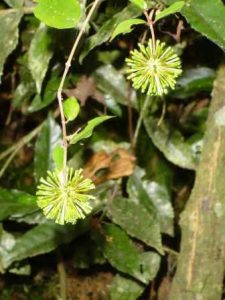
Cephalanthus natalensis. Photo: Bart Wursten. Source: Flora of Zimbabwe
Also present were Cephalanthus natalensis (flowers in heads), Newtonia buchananii, Albizia adianthifolia and Choristylis rhamnoides. As is well known, Tom often remarks that in the Tree Society it is the ladies that climb the trees and for once this was almost true when Soo Fawcett climbed up a steep rocky slope to look at an unidentified tree. Tom then went up to have a look and identified it as Eugenia nyassae.
Back to the cars, lunch and on towards Aberfoyle, stopping to feed on a red-fruited Rubus which was growing by the road. This was a distinctive species with pinnate leaves and suckering stems – unnamed at the moment.
At the bridge at Aberfoyle, Tom showed us the enormous specimens of Xylopia aethiopica. Tom pointed out that this species tends to have several, small, regularly-arranged buttresses whereas Newtonia has one large dominant buttress which upsets the symmetry of the trunk. The slash is creamy-white and the branches are horizontally arranged. When we eventually saw a smaller specimen, the leaves were typical of the Annonaceae, namely they were arranged in a plane and were aromatic when crushed. There were no stipules.
Nearby was another forest Strychnos, S. angolensis, which like lucens has tendrils. We were also shown the rare forest climber, Rhaphiostylis beninensis. This is another species difficult to place – it belongs to the Icacinaceae, which we tend to see rarely in the savanna (only Apodytes really). As usual, it had the usual forest adaptations of glossy green leaves and drip tip.
A further short drive took us to Ficus modesta. After many attempts to hook a specimen, a youngster from the Estates, Lovemore, climbed up and fetched a bit. Some doubt now exists as to what this actually is: it might be merely Ficus scassellati.
We then walked in darkening conditions along the edge of the forest and then into the forest by the river. It is a most beautiful place with epiphytes crowded on the tree trunks. Here was Filicium decipiens, Alchornea hirtella, Artabotrys monteiroae and the surprisingly tall forest grass, Olyra latifolia.
Another very successful day, full of interest.
FINALLY
A very big thank you to Nick and Soo Fawcett for being so welcoming, for making the arrangements, liaising with Tom and Maureen and ferrying us around the estate. With their help and support everything operated very efficiently and enabled us to devote as much time as possible to looking at plants.
A similar very big thanks must also go to Tom Müller for leading us to the best spots and being able to name all the woody plants we saw. Also for his remarkable ability to interpret and explain the dynamics of the woody vegetation we visited.
I would also like to thank our tireless secretary, Maureen for making all the arrangements from the Harare end.
-Mark Hyde
RAINFORESTS: by Peter Taylor
I read with great interest the reports on the Tree Society visit to the rain forests at the Eastern Highlands Tea Estates in Tree Life 274.
In late July 2002 I had occasion to spend two nights in the Moribane Forest in Mocambique and was absolutely enthralled by the experience. The Moribane Forest is similar to Chirinda Forest in Zimbabwe, but covers a much larger area and even has elephants living there.
The forest lies within the Area Conservacao Transfronteira Chimanimani in the Manica Province of Mocambique and has been afforded complete protection by the Mocambique government. It is situated on the road from Chimoio to Dombe just before the road drops off down the escarpment. The road is gravel but well maintained and all weather.
There is a camp, Moribane Acampamento at Chief Mpunga’s which is basic, consisting of five thatched pole and dagga chalets, each with two beds and a site to pitch tents. The whole camp is hired, not individual chalets, so for my wife and myself it worked out a bit expensive.
The forest is out of this world! One or two familiar faces, otherwise completely unknown to myself. Werner Fibeck would have a field day with the epiphytic orchids and ferns. Butterflies were another very noticeable aspect. There are guides to take you on walks and you may get lucky enough to see elephants.
It is my intention to return at my earliest opportunity and spend more time there.
A possible Tree Society visit with Tom?
EWANRIGG: CHRISTMAS SOCIAL: 15 DECEMBER 2002
The vagaries of the fuel supply had us wondering how many people would attend the Christmas Social at Ewanrigg Botanical Garden (80 kms there and back from Harare) but a pleasing number of about 25 did, including a number of overseas visitors. We parked in a laager-like pattern in the shade of a cluster of ash trees (Fraxinus spp.) and from there walked back towards the main gate.
Our guest of honour was Tom Müller who twice this year has led the Society on memorable longer trips to areas of forest in the Eastern Highlands: high-altitude forest at Nyanga in January and medium to low-altitude at the Eastern Highlands Tea Estates in October. As well as this he has continued to lead us every month on the botanic garden walks when we study particular genera or families in more depth. We are most grateful to him for such a major contribution to the Society.
The morning walk, which was a very relaxed affair, took us through an interesting mixture of native and planted trees with both Tom and Lyn Mullin providing an interesting commentary on what we saw.
The Society’s main interest is in native trees and we tend not to look so hard at exotic trees – indeed, there is a definite view that they are of less interest than native ones. For example, many people’s attitude to gum trees is not particularly positive. Furthermore, there is a definite shortage of a suitable compendium (of the sort like Coates-Palgrave) which provides both botanical and general information about the exotic trees commonly planted in Zimbabwe. However, I think we should not neglect these trees: there are numerous facts of interest and relationships with our native trees and they also widen our horizons by introducing us to plant families we would not normally study. The following are some comments on a very small selection of the trees seen.
Lophostemon confertus is a tree which is planted all along Churchill Avenue in Alexandra Park. Waiting at the traffic lights if you are driving from College Rd, you stare at a fine specimen straight in front of you. For years, I thought this was a gum tree – although the bark is rough and not smooth and peeling. In fact, Lophostemon is in the same family (Myrtaceae), it is an Australian tree and it appears to differ from Eucalyptus in not having the operculum (or bud-cap) which is present in the flowers of Eucalyptus.
In the past the species was known as Tristania conferta (I am grateful to Lyn Mullin for telling me about this tree) and the English name seems to be variously Brisbane Box or Queensland Box.
The Myrtaceae provided us with a number of other trees. Syncarpia glomulifera (the Turpentine tree) is another evergreen tree with its capsules bunched together. Syzygium cumini (the Jambolan) is a native of tropical Asia; it provides edible fruit and according to Tom is commonly planted in the Indian areas of Harare. It is also a good shade tree. A white-flowered Callistemon salignus also caught our eye; it looked rather like a Melaleuca (also Myrtaceae). This is again an Australian tree – Queensland and New South Wales.
Brachychiton spp. were also seen. Three species appear to be commonly planted around Harare: acerifolius (leaves lobed like a maple and with striking red flowers); populneus (leaves small like a poplar and whitish flowers) and discolor (leaves also lobed but with rather duller flowers). Note incidentally the masculine ending to the Latin names; it used to be treated as neuter and therefore ending in -um.
All of these trees have synonyms in Sterculia: Sterculia acerifolia etc. Every morning I walk past a fine row of Brachychiton discolor in George Silundika Avenue and these look very like sterculias: flowers, leaves and fruits all very similar. So, why are they in a different genus? The answer seems to be a floral technicality: in Sterculia the anthers are in 1 or 2 whorls whereas in Brachychiton they are “crowded without order”.
The final point of the walk was the stunning pink Cassia near the main entrance, which Tom thought was C. roxburghii. The clusters of flowers sit above the plane of the branches.
A magnificent bring and share lunch then took place with wine conversation flowing freely. However, our enthusiasm and energy levels were not dampened and in the afternoon a group set off to look at the herb garden (the herb wheel as I see it is called). This was laid out in 1979 by the then curator, Gerry Buckland. It is like stepping back into a European flora: feverfew, horse radish, comfrey, fennel and many others but also local plants which are useful: the Makoni tea bush, Jatropha curcas and Hypoxis species. Once again, this deserves a full write-up and perhaps we will return there later in the year to do it justice.
Various questions came up in our walk which we couldn’t answer at the time. Feverfew is Tanacetum parthenium (according to the latest British flora I have – Stace, 1997). It is strongly aromatic and has yellow disc florets and white ray florets, although sometimes the ray florets are missing or (more commonly) occur in a flore pleno form. Tansy is Tanacetum vulgare; this is a much taller plant; the ray florets are absent so that the flower heads appear yellow.
Two final questions were – what are the families of Liquidambar styraciflua (it is Hamamelidaceae) and Gaultheria (Ericaceae).
It was a memorable day with a different emphasis to our normal outings and I hope, if members are interested, that we can spend more time this year looking at our exotic flora.
-Mark Hyde
THOSE INVASIVE ALIENS!
Sabonet News Volume 7 No 2 (September 2002) continues its series of articles on non-indigenous plants that have already become invasive in South Africa, or have the potential to do so. This is Part 4 in the series and deals with the family Myrtaceae; the author Lesley Henderson.
Over the past couple of years I have come across a number of South African articles in journals, and even some books, waxing wrathful on the subject, usually using emotive terms such as “green deserts”, “green cancer”, etc. The term “invasive aliens” is the least emotive one in use in South Africa, but even so it conjures up visions of horrible little men from Mars swarming all over Earth. In spite of the title of the Sabonet article, “Invasive Alien Plants in Southern Africa”, the author sticks to the controlled language of a responsible scientist trying to see and report on facts. The offending genera in Myrtaceae are Eucalyptus (7 species), Leptospermum (1 species, possibly 2), Metrosideros (1 species), Psidium (3 species + 1 hybrid), Eugenia (1 species), Syzygium (2 species, possibly 3), and Callistemon (possibly 1 species).
This note will be confined to the eucalypts.
The offending Eucalyptus species are, in alphabetical order: camaldulensis, cladocalyx, diversicolor, grandis, lehmannii, paniculata, and sideroxylon. From the Zimbabwean viewpoint we can eliminate cladocalyx, diversicolor, and lehmannii because they are all winter-rainfall species not suited to our summer-rainfall conditions. They have been planted here, but have failed. Of the remaining 4 species E. camaldulensis is widely planted in the drier parts of Zimbabwe, mainly in the form of fuelwood or pulpwood plantations. Very occasionally one might find the odd seedling growing outside the boundaries of the plantation, but this is rare. E. grandis is the most important commercially-planted eucalypt in this country, and while it occasionally “escapes” the reason for the escape is practically always associated with fire close to a stand of trees. The ecology of the genus Eucalyptus is intimately tied up with fire, and in our conditions usually man-made fire. Young eucalypt seedlings in Zimbabwe cannot compete with our indigenous grasses during their first 12 months from seed, but remove the competition of the grasses by fire and the eucalypts may get away if other factors are in their favour. It is surprising to find E. paniculata and E. sideroxylon listed as invasive in South Africa. These two are totally inoffensive in Zimbabwe, and casting about for a possible explanation for the differing behaviour I am reminded that South Africa receives a lot of spring rain, which we generally do not. Our “spring” tends to be very hot and very dry, and not conducive to the survival of newly germinated seedlings. As an aside, I suspect that E. paniculata in South Africa (as it generally is in Zimbabwe) is in 50:50 mixture with E. siderophloia. The two species are very easily confused, and were probably growing in mixed stands in South Africa before the end of the 19th century. All our early seed supplies came from that country.
It is an important characteristic of the eucalypts that seed is not dispersed very far from the parent tree. Wind is the most important agent of dispersal, and in most species it is probable that a single tree is capable of consistently seeding an area with a radius equivalent of no more than one tree-height. In very windy conditions seed may land up to 2 or 3 times the parent tree’s height. Contrast this with the winged seed of Pinus patula, which may land a kilometre or more from the parent tree.
Another possible agent of seed dispersal in eucalypts is stream water, especially for species such as E. camaldulensis (river red gum, not Red River gum as printed in the Sabonet article). The only instance I have seen of genuinely invasive E. camaldulensis in Zimbabwe was on a tributary of the Mubvinsi (Umwindsi) River in Glen Lorne. A small planting of the species alongside the stream had resulted in about 400 metres of regeneration downstream of the original trees (which were of indeterminate age).
My one criticism of the Sabonet article is the statement “Eucalypts are well known for their ability to use large volumes of water” I would have hoped to have seen a quantitative figure put on the “large volumes of water”. This is an accusation that has been bandied about so often that it is accepted as true in all circumstances. For those who do worry about eucalypts and water may I recommend an excellent FAO (1985) publication titled “The Ecological Effects of Eucalypts”, produced by a professional agriculturist and a professional forester who went into the matter in great depth and concluded that there was no clear evidence that eucalypts used more water than other fast-growing tree species.
I hope this note provides some perspective for those who might read the Sabonet article. It is too easy for the “anti-exotic lobby” to get carried away by its own emotive language, and if we were to take “anti-exoticism” to its logical conclusion we would have to get rid of most of our food crops! I have said it before, and will no doubt say it again: the real problem with “invasive aliens” does not lie so much with the plants as with land owners who fail to manage their land.
-Lyn Mullin
BRACHYSTEGIA IN SOUTH AFRICA
Sabonet News Volume 7 No 2 (September 2002) reports the discovery of a second species of Brachystegia in the Soutpansberg region of South Africa. This is tentatively identified as B. utilis/torrei, but no flowering material has yet been found. The author, Norbert Hahn, indicates that the two Soutpansberg brachystegias are not associated with the “Zimbabwe miombo floristic element”, but with the Eastern Highlands floristic element, a “relic of an ancient tropical floral element that extended across the Eastern Highlands of Zimbabwe into the Soutpansberg”. It is interesting that the Venda common name for the Soutpansberg brachystegia community is mutsiwa (“the one that is left behind”), indicating that the local people are aware that this is a brachystegia community isolated from its main distribution north of the Limpopo.
It seems that in the Soutpansberg community there are a number of forms intermediate between B. spiciformis and B. utilis/torrei, suggesting that the latter is being assimilated into the dominant B. spiciformis genome.
-Lyn Mullin
ROOTNOTE
I think that I shall never see
A billboard lovely as a tree
Perhaps unless the billboards fall
I’ll never see a tree at all.
Ogden Nash. “Song of the Open Road”
MARK HYDE CHAIRMAN


